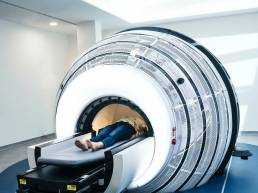Oncological Pain
- Home
- TREATMENTS
- Oncological Pain
What is cancer pain
Cancer pain refers to pain that cancer patients may experience, Whether it is due to the progression of the disease itself, caused by a tumour and its possible metastases. It can also be caused by associated treatments and pathologies.
It is a very common symptom in this type of patient. Approximately 30-50% of cancer patients experience pain, and at certain stages of the disease this percentage can be as high as 70-80% of people with advanced cancer.

Causes
The causes behind cancer pain
There are several causes of cancer pain, depending on the type of cancer or tumour the patient suffers from:
Pain due to tumour invasion
Pain due to continued tumour growth is the most frequent cause among these patients. In this type of patient the cause of cancer pain is due to tumour invasion. About 70% of the pain is caused by the invasion of bone structures, nerve or vascular elements, or by the infiltration of viscera by the tumour.
Oncological pain resulting from treatments.
Another type of pain is pain resulting from various cancer treatments: after undergoing chemotherapy, radiotherapy or surgery. In these cases around 20% of the pain is related to diagnostic and therapeutic procedures or their side effects.
Cancer pain due to neoplasia
Oncological pain can also occur due to neoplasia-induced syndromes. It is a rare complication in cancer patients. It is a reaction of the immune system in the early stages of cancer, which mistakenly attacks the nervous system when it detects tumour cells, causing varied and sometimes disabling neurological symptoms.
Other non-directly oncological causes of pain.
It is possible to suffer pain during oncological disease due to causes unrelated to cancer, but which contribute to the patient's discomfort, such as when osteoarthritis, osteoporosis or ischaemic heart disease are present.
We can conclude that 70% of pain in patients with advanced cancer comes from the progression of the disease itself, while the other 30% is linked to the cancer treatments themselves or other causes.
Moreover, this type of pain can be triggered by inflammatory causes that can provoke somatic pain (characterised by being very localised and by the destruction of the body’s own tissues), neuropathic pain (due to changes in the nerve tissues caused by the advance of the tumour itself or after the appearance of metastasis) or visceral pain, the latter being the most diffuse and difficult to locate.
Types of oncological pain according to their durability
Depending on the durability of this pain, we could also be talking about two main branches:
- Acute pain: pain that lasts for a short period of time, less than six months, and which normally appears repeatedly in the patient.
- Chronic pain: the opposite of acute pain, as this pain develops slowly and lasts over time.
The treatment of oncological pain is one of the most complex and therefore, on occasions, a multidisciplinary assessment is necessary for its management.
There is also oncological pain known as breakthrough pain.
Breakthrough pain is a sudden and intense exacerbation in cancer patients suffering from controlled chronic pain.
How to assess cancer pain
Before starting the treatment of cancer pain, it is necessary to assess each case individually to observe the patient’s physiological mechanisms and other factors that could affect or increase pain. Some aspects to take into account for this assessment are:
- The intensity of pain is complex, but there are various scales to try to measure it.
- It is necessary to be able to clarify the type of pain felt by the patient and differentiate between somatic, visceral or neuropathic pain, as the treatment will vary depending on this.
- The way in which the pain appears is important, because it usually creates a pattern of activity, so it can be observed when the pain starts, how long it usually lasts and how it affects the patient.
- There are some factors external to the disease that can have a negative impact on the patient’s condition, such as temperature. Humidity or movement. And others that could have a positive effect, such as rest or the same atmospheric characteristics.
- Symptoms derived from cancer pain such as vomiting, nausea or problems in the digestive system must be taken into account.
- The repercussions of this pain on the patient’s life should be taken into account as some of them can limit their daily life and affect their social relations, causing a change in their mood.
- A medical check-up is necessary to analyse the patient’s responses to the pain they may be feeling.
Oncological pain, one of the ZAP-X treatments
One of the many applications of this technology today is focused on treating cancer pain in patients arriving at the centre.
Producing relief for those who do not have many options for treatment is something that has been emphasised: the fact of offering other solutions to the common ones that already exist on the market, such as the use of medicines aimed at calming pain.
The fact of using this painless, outpatient system, which only lasts a few minutes, opens a huge door of advances for oncological pain, above all to offer non-invasive irradiation solutions that avoid patient interventions with their respective complications.
Radiosurgery has come into play to provide an alternative for these patients, aimed at making a difference and evolving to provide the best response to all those who need it.
The treatment of oncological pain is one of the most advanced processes in the field of Radiosurgery due to the ZAP-X, mainly aimed at helping with baseline pain, breakthrough pain, neuropathic pain or refractory pain, which is pain that will continue to be treated in whatever way it is treated.

